(To find your dreams have washed away)
Following M’s lecture, the group boarded our bus with Whisperers in place and set off for a walk across the Harbour Bridge – a walk not to be confused with the Bridge Climb – an activity that has participants ascend and descend the bridge’s steel arch and that’s sometimes referred to as the Bridge Walk. (Two in our RS group had arrived early and taken this not for me adventure.) Our walk would take us along the pedestrian section of the structure.
Even before the construction of its two architectural icons – the Harbour Bridge and the Opera House – Sydney Harbour was considered among the most beautiful natural harbors in the world. Here’s a simplified version of how a geologist might describe the processes that formed the harbor (because simple is the best way for me to understand it).
The creation of the harbor according to geologists
The normal processes of deposition and erosion laid layers of sandstone and shale some 300 million years ago (MYA). Plate tectonics and volcanism beginning in the Jurassic period (beginning about 200 MYA) raised these rocks to their present height. Erupting volcanoes created fissures in the rocks allowing lava to flow and harden into dykes of basalt. These are still prominent around Bradleys Head, North Head, and Nielsen Park. (You can see these locations in the screen capture below taken from Google Maps.
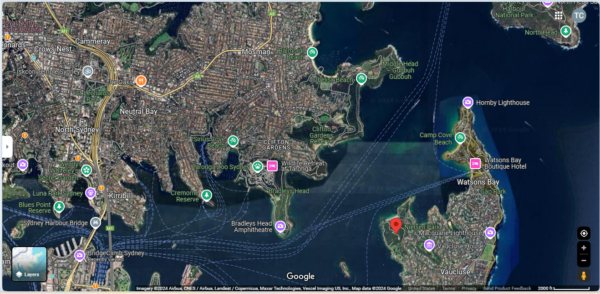
[Satellite image from Google Maps]
They might also note that the eastern and western sides of the harbor are comprised of two quite different types of rock. On the east you find hard Hawkesbury sandstone that form the vertical cliffs that distinguish that side of Sydney Harbour. The softer Ashford shale found on the harbor’s western edge breaks apart more easily and erodes without forming cliffs. Here the harbor is flatter and it’s home to the area Sydneysiders call The Rocks which we’ll briefly visit later this morning.
Like many harbors around the world, Sydney’s harbor is also an estuary. It formed about 29,000,000 years ago that has experienced the effects of two significant changes – one natural and one gifted by humans. The natural change occurred about 17ooo years ago from glacial melt and the concomitant rise in sea level. According to a paper by Lorraine Chaffer,
Sydney Harbour is one of the most modified harbours in the world. While under water impacts are invisible to most people, the extent of urban development and modifications to the shoreline are the most dominant and visible change. Today, 90% of the catchment is urbanised or industrialised and 50% of the foreshore armoured.
If you’re interested, you can read more about the estuarine nature of Sydney Harbour here.
The creation of the harbor according to the D’harawal
In ancient times, the D’harawal people described the sea as being farther to the east and the area presently known as the Sow and Pigs reef was dry land in a fertile valley they called Burra Birra.
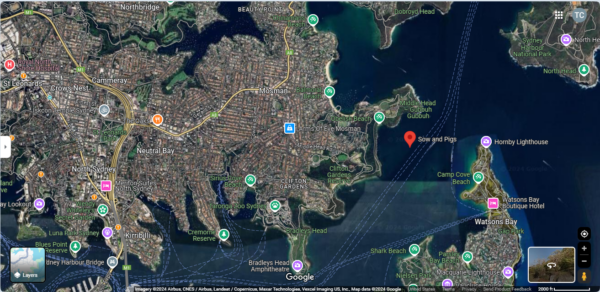
[Satellite image from Google Maps]
It was the home of the Eel Dreaming Spirit. For the D’harawal, this was a sacred place where women performed the Butowee ceremony that taught every child the ways of the people and where those children received protection from evil spirits.
The land here was particularly fertile and rich with food.
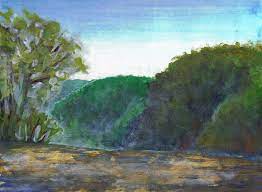
However, over time the people became fat and lazy and forgot the ways of the people. The men no longer honored the spirits of the animals they hunted and killed and wasted much of their prey eating only the parts they liked while leaving the remainder to rot away. Similarly, the women no longer paid their respects to the earth mother or gave thanks for the food they received so easily and ceased teaching their children the ways of the people.
Because the children grew to adulthood without knowledge of the laws, they thought it unnecessary to learn and obey them. They formed bands that destroyed the shelters of the elderly and stole fishing spears and hunting weapons that they then used to fight other bands. One band approached the home of the great eel Parra Doowee that was guarded by the old warrior, Kamarai.
Although Kamarai went to greet them in peace, they attacked him with their spears. Bleeding from many wounds, the old man fell to the ground. In a deep pool in the river the great eel heard the commotion and heard the cries of help from his old friend. It swam up to the surface of the pool. The lawless ones saw the great eel and threw their spears at him in fear as it pulled itself up out of the water.
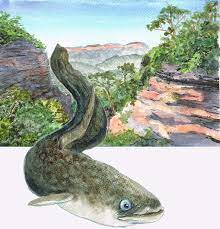
Its great body moved towards its old friend as the last spear of the lawless ones struck its tail. When it saw that Kamarai had died of his wounds, it cried out in grief and pain and struck the ground with its great tail dislodging the spear. The earth began to shake violently and a great chasm opened up in the ground following the fleeing lawless ones and swallowing them as they fled towards the flatlands.
Then a storm came in from the sea, and the waves crashed across the flatlands until they reached the cliffs that marked the beginning of the highlands.
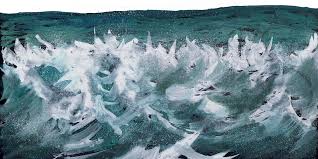
“Let this be a warning:”, the great eel said. “The laws of this land must be obeyed, and the proper ceremonies must be carried out in the proper manner.” It turned to look at the Boora Birra, slowly being engulfed by the waves. “And the Boora Birra will now be a place where the sea creatures take their children to teach them the lore of the sea.
Because good lessons can always be learned from evil, this place will be safe for the people to hunt and to fish and live and teach the laws.”
The great eel slipped silently into the water and with a splash of its tail disappeared beneath the waves, the people watched the waves, hoping for a glimpse of the great eel as it made its way to its new home. One of the children, a young boy went to the water’s edge then looked back at his mother and smiled and spoke in a voice that was not his “Until we forget again” he said, “Until we forget again.”
This story and the images used above are part of the D’harawal Dreaming and I have shortened and adapted it to fit this post. You can read the complete story at Dharawal Stories.
Note: The Boora Birra is one of the sacred Dreamings that details the creation of Sydney Harbour. Dreaming stories are passed on from generation to generation and the Boora Birra Dreaming Story has been shared for thousands of years. Not coincidentally I suspect, its timing coincides with archaeological reports of the Last Glacial Maximum.Â
You might see references to the creation stories of Australia’s Indigenous Peoples described as “The Dreamtime.” This term was probably introduced in the mid 1890s by Baldwin Spencer, who was a prominent anthropologist working at the time with the Aranda people in the area around Alice Springs.
Although Dreamtime has come into common usage, many Aboriginal people prefer the term “The Dreaming.” One key element of the concepts attached to their creation stories is the notion that creation isn’t seen as having happened at a specific time in the past but rather is a timeless, ongoing spiritual reality intertwined with the present and future.
Using the term Dreaming is a more accurate description encompassing the concept of moving from ‘dream’ to reality which in itself is an act of creation. None of the hundreds of Aboriginal languages contain a word for time.